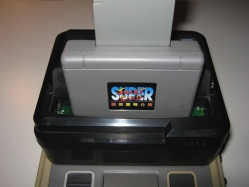
Autopsy:
This is one of the first cartridges based on Flash Memory for the Nintendo Gameboy and Sega Gamegear.
The use is quite complex and you must do via the Super Wildcard DX, the Super Smart Card programmer is inserted into the free slot of the Super Wildcard DX and over this the Flash Cartridge.
The file transfer of the games in format .GB/.GG are done by a pre-loaded software through the backup unit.
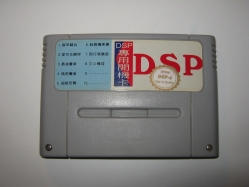
Autopsy:
The Super Nintendo DSP 4 cartridge made by Front FarEast is a cartridge addon for the Super Wildcard DX.
When you using this cartridge you will can play some games for the Super Nintendo that use special chips inside the cartridges (DSP) and not present in the original backups (files).
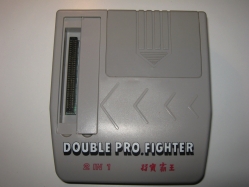
Autopsy:
The Double Pro Fighter is a Backup Copier for Super Nintendo (Super Nes / Famicom) and Sega Megadrive (Sega Genesis) made by China Coach Limited, and shipped with 16 megabits (2 megabytes) of RAM, expandable up to 32 megabits.
The top of the unit contains two females cartridge port for inserting SNES cartridges and Megadrive (Genesis) cartridges. The left hand side contains the floppy drive. The bottom of the unit contains two male cartridge port that inserts into the Super Nintendo or Megadrive (Genesis).
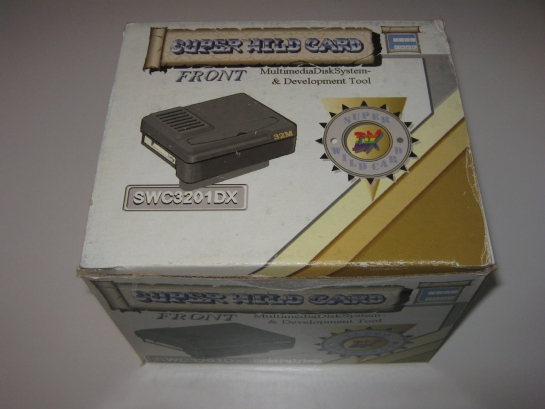
Autopsy:
The Super Wildcard DX is a Backup Copier for Super Nintendo (Super Nes / Famicom) made by Front FarEast (FFE), and shipped with 32 megabits (4 megabytes) of RAM, expandable up to 96 megabits.
The top of the unit contains a female cartridge port for inserting SNES cartridges. The left hand side contains the floppy drive. The bottom of the unit contains the male cartridge port that inserts into the Super Nintendo on the back you can found the parallel port to interface with the computer.
When powered on, the unit launches into a graphical menu. Each of the menu’s 8 items lead to sub-menus:
- Wildcard Options allows users to run programs, transfer cartridges to disk, edit memory or obtain program information.
- Disk options allow users to format disks, rename files, delete files, edit files, and copy files.
- Realtime Save Options allow users to backup and restore real time save data.
- Password options allow users to edit, backup and restore passwords, and search for cheat codes.
- Cart options allow users to run a cartridge, transfer programs, transfer battery RAM, and edit memory.
- Game/Utility options include a PCX picture viewer, a freeware game (Shingles), and a demo (in Chinese).
- Setup options include screen setup, user message, and reset to default.
- Diagnostics include self test, Wildcard info, System info, and credits
The Super Wild Card DX it’s fast, simple to use, and reliable. Its memory editing capabilities and password features greatly expand the functionality of the SNES, and it’s high compatibility means almost anything can be dumped and played.
Download: Super Wildcard DX (EPROM & EEPROM DUMP) (468)
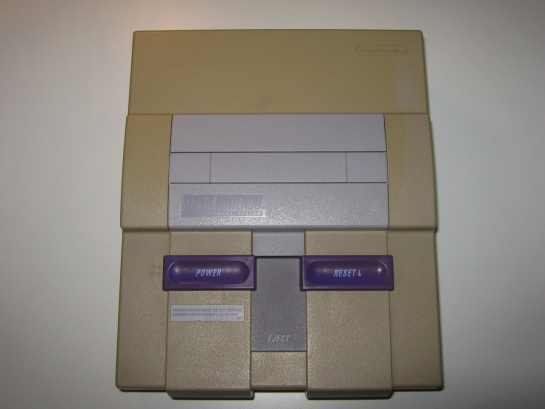
Autopsy:
from Wikipedia:
The Super Nintendo Entertainment System (also known as the Super NES, SNES or Super Nintendo) is a 16-bit video game console that was released by Nintendo in North America, Europe, Australasia (Oceania), and South America between 1990 and 1993.
In Japan and Southeast Asia, the system is called the Super Famicom (スーパーファミコン?, officially adopting the abbreviated name of its predecessor, the Family Computer), or SFC for short. In South Korea, it is known as the Super Comboy (슈퍼 컴보이) and was distributed by Hyundai Electronics. Although each version is essentially the same, several forms of regional lockout prevent the different versions from being compatible with one another.
Designed by Masayuki Uemura, the designer of the original Famicom, the Super Famicom was released in Japan on Wednesday, November 21, 1990 for ¥25,000 (US$210). It was an instant success: Nintendo’s initial shipment of 300,000 units sold out within hours, and the resulting social disturbance led the Japanese government to ask video game manufacturers to schedule future console releases on weekends. The system’s release also gained the attention of the Yakuza, leading to a decision to ship the devices at night to avoid robbery.
source: wikipedia
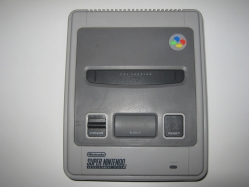
Autopsy:
from Wikipedia:
The Super Nintendo Entertainment System (also known as the Super NES, SNES or Super Nintendo) is a 16-bit video game console that was released by Nintendo in North America, Europe, Australasia (Oceania), and South America between 1990 and 1993.
In Japan and Southeast Asia, the system is called the Super Famicom (スーパーファミコン?, officially adopting the abbreviated name of its predecessor, the Family Computer), or SFC for short. In South Korea, it is known as the Super Comboy (슈퍼 컴보이) and was distributed by Hyundai Electronics. Although each version is essentially the same, several forms of regional lockout prevent the different versions from being compatible with one another.
Designed by Masayuki Uemura, the designer of the original Famicom, the Super Famicom was released in Japan on Wednesday, November 21, 1990 for ¥25,000 (US$210). It was an instant success: Nintendo’s initial shipment of 300,000 units sold out within hours, and the resulting social disturbance led the Japanese government to ask video game manufacturers to schedule future console releases on weekends. The system’s release also gained the attention of the Yakuza, leading to a decision to ship the devices at night to avoid robbery.
source: wikipedia
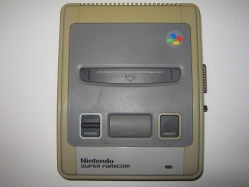
Autopsy:
With this console and the Backup unit Super Wildcard DX in the 90′s the Nightfall group has released several Trainer / Crack and Demo for the Snes / Famicom scene.
from Wikipedia:
The Super Nintendo Entertainment System (also known as the Super NES, SNES or Super Nintendo) is a 16-bit video game console that was released by Nintendo in North America, Europe, Australasia (Oceania), and South America between 1990 and 1993.
In Japan and Southeast Asia, the system is called the Super Famicom (スーパーファミコン?, officially adopting the abbreviated name of its predecessor, the Family Computer), or SFC for short. In South Korea, it is known as the Super Comboy (슈퍼 컴보이) and was distributed by Hyundai Electronics. Although each version is essentially the same, several forms of regional lockout prevent the different versions from being compatible with one another.
Designed by Masayuki Uemura, the designer of the original Famicom, the Super Famicom was released in Japan on Wednesday, November 21, 1990 for ¥25,000 (US$210). It was an instant success: Nintendo’s initial shipment of 300,000 units sold out within hours, and the resulting social disturbance led the Japanese government to ask video game manufacturers to schedule future console releases on weekends. The system’s release also gained the attention of the Yakuza, leading to a decision to ship the devices at night to avoid robbery.
source: wikipedia































































































Recent Comments